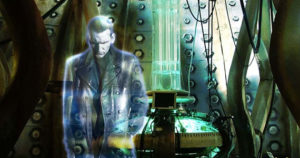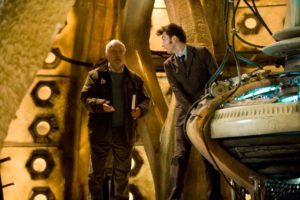Who Mysteries: Is Big Finish Canon If Doctor Who References It All the Time?

By Gustaff Behr.
In fiction, canon refers to material that is accepted as officially being part of a particular franchise’s universe. Another word for canon is continuity, which Doctor Who often plays fast and loose with, depending on the showrunner (looking at you, Chibnall). Canon within the Doctor Who franchise is difficult to define as there are multiple licensed works in production at any one time, namely the TV show, books, comics and audios.
Within the fandom we resolve this issue by assigning different levels of canonicity to different media, but it’s generally accepted that the TV Series comes first, then Big Finish, then either comics or novels. The BBC, as well as several producers of Doctor Who, tend to avoid making decisions about canonicity. In recent years though, Big Finish has overtaken Doctor Who in terms of quality and quantity, but have been unable to shake the ‘don’t buy audios, they aren’t canon’ argument fans lodge. For someone like myself who has listened to hundreds of Big Finish titles over the years, it’s a little disconcerting given that this is simply not true.
“The Night of the Doctor” is not the only time the television series has made direct reference to Big Finish. It has been happening since 2002. There is so much material that the television references (directly) that, if ‘Big Finish isn’t canon because it’s never referenced or never affects the television series in any way’ is the only excuse, well then, we need to talk.
Here are some direct examples of times the television series peeked at Big Finish’s playbook…
1. The Stones of Venice (Main Range) – 19 March 2001
 The Eighth Doctor revealed one of the prevailing reasons for why he left Gallifrey. He claimed that it was his belief that ‘good will always prevail over evil’. If this sounds familiar, it’s because it is. This is the exact same reason the First Doctor gave to ‘Bill’ during the events of “Twice Upon a Time”…sixteen years later.
The Eighth Doctor revealed one of the prevailing reasons for why he left Gallifrey. He claimed that it was his belief that ‘good will always prevail over evil’. If this sounds familiar, it’s because it is. This is the exact same reason the First Doctor gave to ‘Bill’ during the events of “Twice Upon a Time”…sixteen years later.
2. The Eye of the Scorpion (Main Range) – 17 September 2001
 One of the skills the Doctor has continually shown off in the New Series is his ability to tell a time period by smelling the air or parts of the environment. This was first demonstrated in “The Unicorn and the Wasp”, but it was the Fifth Doctor who first utilized this technique, making this one, but not the only case where the TV show has adopted a skill introduced in the audios.
One of the skills the Doctor has continually shown off in the New Series is his ability to tell a time period by smelling the air or parts of the environment. This was first demonstrated in “The Unicorn and the Wasp”, but it was the Fifth Doctor who first utilized this technique, making this one, but not the only case where the TV show has adopted a skill introduced in the audios.
3. Colditz (Main Range) – 22 October 2001
 This one can go either way, but like most of the entries on this list, it is very suspicious how well it fits into the overall continuity of Doctor Who. Near the end, Feldwebel Kurtz dies by being half inside and half outside the TARDIS when it dematerializes. The sight traumatizes Ace to a degree. Fast-forward to “The Husbands of River Song” and the TARDIS now has a safety feature that prevents it from dematerializing when someone is both inside and outside it. I wonder where the Twelfth Doctor got that idea from.
This one can go either way, but like most of the entries on this list, it is very suspicious how well it fits into the overall continuity of Doctor Who. Near the end, Feldwebel Kurtz dies by being half inside and half outside the TARDIS when it dematerializes. The sight traumatizes Ace to a degree. Fast-forward to “The Husbands of River Song” and the TARDIS now has a safety feature that prevents it from dematerializing when someone is both inside and outside it. I wonder where the Twelfth Doctor got that idea from.
4. Comeback (Sarah Jane Smith) – 7 March 2002
 K9 Mark-III ceased to function during this story and was eventually regulated to being left in a box in Sarah’s attic. When “School Reunion” aired four years later, K9 was still broken down and Sarah mentioned him being retired to her attic. New Who, either purposely or accidentally, adapted this very specific plot point introduced by Big Finish many years earlier, into their story. How’s that for direct?
K9 Mark-III ceased to function during this story and was eventually regulated to being left in a box in Sarah’s attic. When “School Reunion” aired four years later, K9 was still broken down and Sarah mentioned him being retired to her attic. New Who, either purposely or accidentally, adapted this very specific plot point introduced by Big Finish many years earlier, into their story. How’s that for direct?
5. Master (Main Range) – 31 October 2003
 The Doctor and Master’s relationship in the New Series is continuously portrayed as childhood friends turned adult enemies. However, during the Classic era, this relationship had almost always been shown to be antagonistic with a hint of begrudging respect. This ‘friendship’ New Who is so fond of actually originates in Big Finish. The Doctor tells the Master, as well as Death later in the story, that he wants his old ‘friend’ back. This was the first occurrence in the history of the franchise where these two refer to themselves as once being friends. Missy echoed the sentiment in the Series 8 finale. In fact, her entire three-season arc revolved around her redemption and the Doctor ‘saving’ her. This was also what the Seventh Doctor vowed to do at the end of the audio, and it’s a significant plot point that has been carried over to later incarnations in multiple stories from Series 3 onwards.
The Doctor and Master’s relationship in the New Series is continuously portrayed as childhood friends turned adult enemies. However, during the Classic era, this relationship had almost always been shown to be antagonistic with a hint of begrudging respect. This ‘friendship’ New Who is so fond of actually originates in Big Finish. The Doctor tells the Master, as well as Death later in the story, that he wants his old ‘friend’ back. This was the first occurrence in the history of the franchise where these two refer to themselves as once being friends. Missy echoed the sentiment in the Series 8 finale. In fact, her entire three-season arc revolved around her redemption and the Doctor ‘saving’ her. This was also what the Seventh Doctor vowed to do at the end of the audio, and it’s a significant plot point that has been carried over to later incarnations in multiple stories from Series 3 onwards.
6. Zagreus (Main Range) – 23 November 2003
 Fans have been speculating about what the Doctor was up to in those series of photographs Clive shows Rose since Series 1 first aired in 2005. One of those images showcased the Ninth Doctor at the John F. Kennedy assassination. But you don’t have to speculate why he was there when you know the Eighth Doctor has claimed that he was once accused of the assassination. Maybe Nine just wanted to clear his good name?
Fans have been speculating about what the Doctor was up to in those series of photographs Clive shows Rose since Series 1 first aired in 2005. One of those images showcased the Ninth Doctor at the John F. Kennedy assassination. But you don’t have to speculate why he was there when you know the Eighth Doctor has claimed that he was once accused of the assassination. Maybe Nine just wanted to clear his good name?
7. The Axis of Insanity (Main Range) – April 2004
 In “The Name of the Doctor” we learned from the Eleventh Doctor that TARDISes die when the Time Lord pilot dies. However, this part of Doctor Who mythos already existed as far back as 2004 when the Fifth Doctor explained it to his companions. As with other entries on this list, this proved to be a significant plot point.
In “The Name of the Doctor” we learned from the Eleventh Doctor that TARDISes die when the Time Lord pilot dies. However, this part of Doctor Who mythos already existed as far back as 2004 when the Fifth Doctor explained it to his companions. As with other entries on this list, this proved to be a significant plot point.
8. Unregenerate (Main Range) – June 2005 [Recorded Nov 2004]
 One of the most memorable scenes in “The Parting of Ways” involved Rose’s conversation with the hologram Ninth Doctor. This idea was never present in the Classic era, but shortly after his regeneration from the Sixth Doctor, the Seventh Doctor recorded a non-interactive TARDIS hologram of himself, so Mel could be informed about what is happening. Very familiar indeed. This TARDIS feature would continue to be utilized in other stories like “Blink” and “Let’s Kill Hitler”, as well as a variation thereof in “The Power of the Doctor”.
One of the most memorable scenes in “The Parting of Ways” involved Rose’s conversation with the hologram Ninth Doctor. This idea was never present in the Classic era, but shortly after his regeneration from the Sixth Doctor, the Seventh Doctor recorded a non-interactive TARDIS hologram of himself, so Mel could be informed about what is happening. Very familiar indeed. This TARDIS feature would continue to be utilized in other stories like “Blink” and “Let’s Kill Hitler”, as well as a variation thereof in “The Power of the Doctor”.
9. Circular Time: Winter (Main Range) – 20 January 2007

10. The Girl Who Never Was (Main Range) – 3 December 2007

And there you have it. Long before the television series showed them to us, Big Finish did them first. I suppose it’s easy to argue that these are all coincidences, but are they? So many of them?
If I had a nickel for every time the television series prominently referenced/adopted or chose to incorporate something that Big Finish did years ago into their stories, I’d have at least ten nickels, which isn’t a lot, but it’s weird that it happened that many times.








